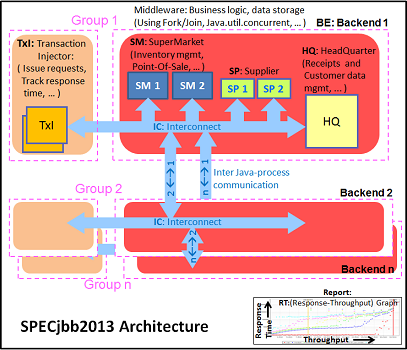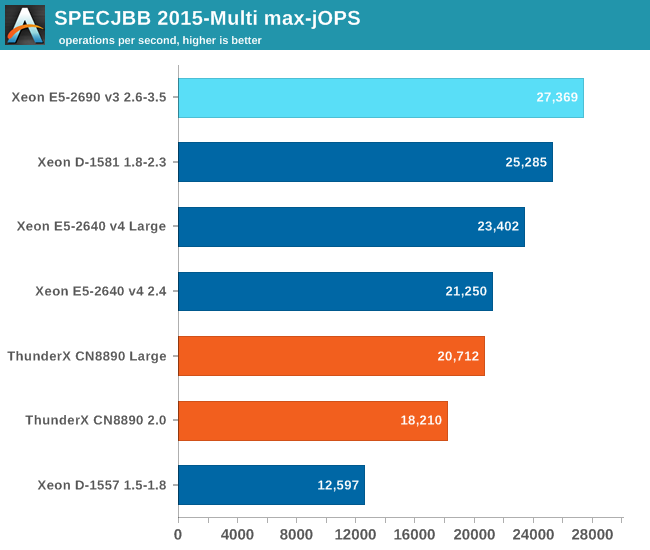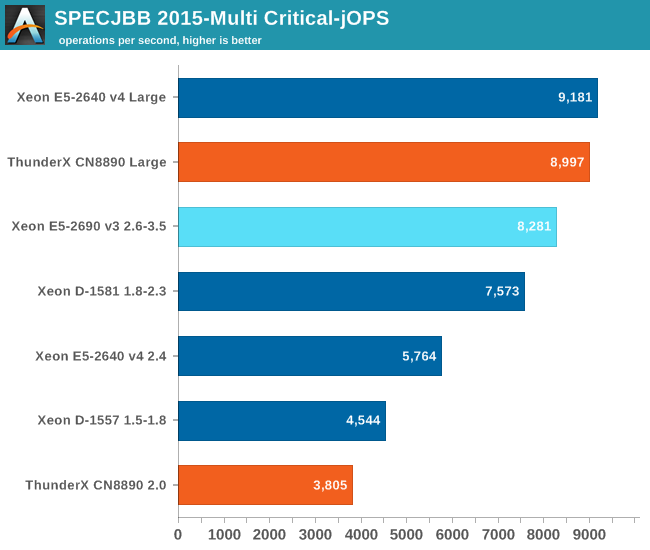Investigating Cavium's ThunderX: The First ARM Server SoC With Ambition
by Johan De Gelas on June 15, 2016 8:00 AM EST- Posted in
- SoCs
- IT Computing
- Enterprise
- Enterprise CPUs
- Microserver
- Cavium
Java Performance
The SPECjbb 2015 benchmark has "a usage model based on a world-wide supermarket company with an IT infrastructure that handles a mix of point-of-sale requests, online purchases, and data-mining operations." It uses the latest Java 7 features and makes use of XML, compressed communication, and messaging with security.

We tested with four groups of transaction injectors and backends. The Java version was OpenJDK 1.8.0_91.
We applied relatively basic tuning to mimic real-world use, while aiming to fit everything inside a server with 64 GB of RAM (to be able to compare to lower end systems):
"-server -Xmx8G -Xms8G -Xmn4G -XX:+AlwaysPreTouch -XX:+UseLargePages"
With these settings, the benchmark takes about 43-55GB of RAM. Java tends to consume more RAM as more core/threads are involved. Therefore, we also tested the Xeon E5-2640v4 and ThunderX with these settings:
"-server -Xmx24G -Xms24G -Xmn16G -XX:+AlwaysPreTouch -XX:+UseLargePages"
The setting above uses about 115 GB. The labels "large" ("large memory footprint") report the performance of these settings. We did not give the Xeon D-1581 the same treatment as we wanted to mimic the fact that the Xeon has only 4 DIMM slots, while the Xeon E5 and ThunderX have (at least) eight.
The first metric is basically maximum throughput.

Notice how the Xeon D-1581 beats the Xeon E5-2640 in a typical throughput situation by 8%, while the SPECint_rate numbers told us that the Xeon E5 would be slightly faster. It is a typical example of how running parallel instances overemphasizes bandwidth. The extra 6 cores (@2.1 GHz) push the Xeon D past the Xeon E5 (10 cores@ 2.6 GHz) despite the fact that the Xeon D has only half the bandwidth available.
The ThunderX offers low end Xeon E5 performance, but that still a lot better than what we would have expected from the SPECint_rate numbers (Dual socket ThunderX = Xeon-D). Once we offer more memory to ThunderX, performance goes up by 14%. The Xeon E5 gets a 10% performance boost.
The Critical-jOPS metric is a throughput metric under response time constraint.

The critical jOPS is the most important metric as it shows how many requests can be served in a timely manner. At first we though that the lack of single threaded performance to run the heavier pieces of Java code fast enough is what made the ThunderX so much slower than the rest of the pack.
However, the 48 threads were mostly hindered by the lack of memory per thread. Once we offer enough memory to the 48-headed ThunderX, performance explodes: it is multiplied by 2.4x! The Xeon E5 benefits too, but performance is "only" 60% higher. Thanks to the DRAM breathing room, the ThunderX moves from "slower than low end Xeon D" to "midrange Xeon E5" territory.










82 Comments
View All Comments
willis936 - Thursday, June 16, 2016 - link
Are you sure that the there are more cores at lower clocks to keep voltage lower? Power consumption is proportional to v^2*f.ddriver - Friday, June 17, 2016 - link
Say what? Go back, read my previous post again, and if you are going to respond, make sure it is legible.willis936 - Friday, June 17, 2016 - link
Alright well if you don't understand why many slower cores are more power efficient even if there was a 0 cycle penalty on context switching then you aren't worth having this discussion with.blaktron - Wednesday, June 15, 2016 - link
48 cores of server processing on 16mb of l2 and 4 channels of RAM? What is this thing designed for. Will be like running single channel celerons as server processors, so decent hypervisor hosts are out, and so is any database work more complex than dynamic web pages.Haravikk - Wednesday, June 15, 2016 - link
Facebook is specifically mentioned as being interested in this, so dynamic web-pages is definitely a valid use-case here. HHVM for example is pretty light on memory usage (so is PHP7 now), especially in high demand cases where you're really only running a single set of scripts, probably cached in a compiled form, plus both scale really well across as many cores as you can throw at them.Things like nginx and MariaDB will be the same, so they're absolutely intended use-cases for this kind of chip, and I think it should be very good at it.
blaktron - Wednesday, June 15, 2016 - link
With no L3 and slow RAM access I'm not sure where you think the scrips will cache. Assuming you ran them on bare metal (horrifying waste of compute) there would be enough, but if you had docker instances or quick spin vms doing your work (as 99% of web servers are) then each instance will only get the tiniest slice of cache to work with. It would be like running your servers, as I said, on a bank of celerons. Except celerons have L3 and don't carry 12 cores per memory channel.spaceship9876 - Wednesday, June 15, 2016 - link
Hopefully someone will release a server chip using 64 cortex A73 cpu cores, i'm pretty sure the cortex a73 will be more power efficient than xeon d. Xeon d beats cortex a57 in power efficiency but i'm pretty sure than cortex a72 will be similar and cortex a73 will beat it.Flunk - Wednesday, June 15, 2016 - link
ARM with ambition?I've heard that before, nothing came of it.
CajunArson - Wednesday, June 15, 2016 - link
Interesting article. This does appear to be the first semi-credible part from an ARM server vendor.Having said that, the energy efficiency table at the end should put to rest any misconceived notions that ARM is somehow magically energy efficient while X86 isn't.
Considering that Xeon E5-2690 v3 is a 4.5 year old Sandy Bridge part made on a 32 nm process and it still has better performance-per-watt than the best ARM server parts available in 2016, it's pretty obvious that Intel has done an excellent job with power efficiency.
kgardas - Wednesday, June 15, 2016 - link
2 CajunArson: (1) you can't compare energy efficiency of CPUs made on different nodes. 28nm versus 14nm? This is apple to oranges. (2) Xeon E5-2690 *v3* is Haswell and not Sandy Bridge and it's not 4.5 years definitely.